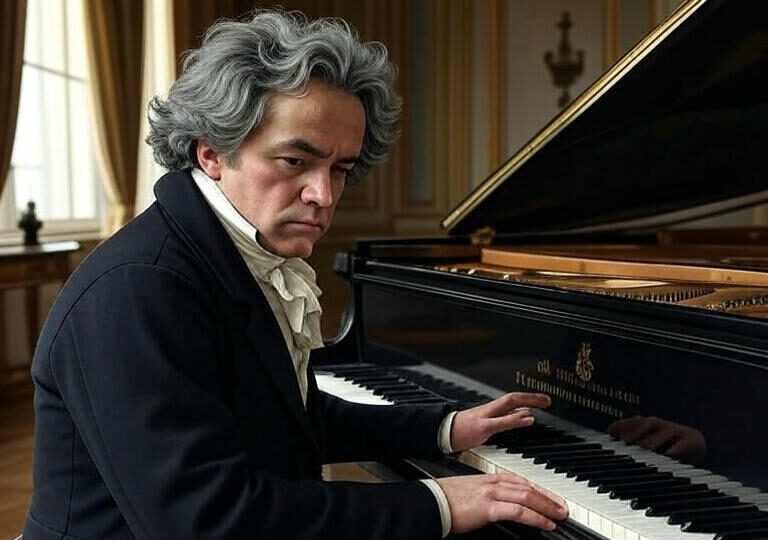Beethoven’s Piano Sonata in E-flat Major, Op. 7: A Masterpiece of Early Genius
Historical Context
Composed in November 1796 during Beethoven’s stay at the Keglevich Palace in Vienna, the Piano Sonata in E-flat Major, Op. 7, was dedicated to Countess Babette Keglević, one of Beethoven’s students. The sonata’s technical demands suggest that the Countess was an exceptionally skilled pianist, capable of navigating its intricate passages. Unlike Beethoven’s earlier sonatas, which were often published in sets, Op. 7 was released as a standalone work by the Viennese publisher Artaria in 1797, earning it the title “Grande Sonate.” This distinction underscores its significance and ambition, marking a leap forward from the Opus 2 sonatas composed just two years earlier. With its four-movement structure—uncommon for many Classical-era sonatas, which typically had three movements—Op. 7 demonstrates Beethoven’s intent to push boundaries and expand the expressive potential of the piano sonata.
Premiere and Reception
While specific details about the premiere of Op. 7 are not well-documented, its publication by Artaria, a prominent Viennese publisher, indicates its immediate recognition as a significant work. The “Grande Sonate” title likely reflected its grand scale and innovative scope, which set it apart from other sonatas of the period. Today, Op. 7 is sometimes described as a “not unknown but somewhat neglected masterpiece,” less frequently performed than Beethoven’s more famous sonatas, such as the “Moonlight” or “Appassionata.” However, it remains a cornerstone of the piano repertoire, valued by pianists for its technical and expressive challenges. Critics often praise Beethoven’s sonatas for their clarity, energy, and emotional depth, qualities that shine in Op. 7. Performances are judged on the pianist’s ability to balance technical precision with artistic interpretation, capturing the sonata’s dynamic contrasts and structural sophistication.
Musical Analysis
Beethoven’s Piano Sonata in E-flat Major, Op. 7, unfolds across four movements, each showcasing his growing mastery of form, harmony, and emotion. Below is an exploration of each movement, designed to be approachable for general readers while highlighting the work’s brilliance.
First Movement: Molto Allegro con Brio
The opening movement, in 6/8 time, bursts with energy and introduces Beethoven’s “new language.” Instead of a traditional melodic opening, it begins with repeated E-flat notes, evoking the bold call of a horn. Scales cascade both upward and downward, creating a sense of motion and drama. The music shifts to the subdominant key before settling into the dominant, where a lyrical, almost singing theme emerges, described as “wonderful” for its warmth and expressiveness. The development section is concise yet intense, filled with dramatic flair. In the recapitulation, Beethoven avoids a mechanical repeat of the opening, instead presenting it fortissimo with triumphant force, contrasting the quiet piano of the exposition. Rhythmic motifs, like repeated quavers, drive the movement forward, while a lyrical passage stands out for its pleading, almost vocal quality. The movement closes with orchestral-like writing, reminiscent of timpani or a drum roll, giving it a grand, theatrical finish.
Second Movement: Largo con Espressione
The second movement, in C major, is a profound Largo con espressione, often cited as one of the greatest slow movements in music. Its key, a third apart from the sonata’s E-flat major, creates a warm, reflective contrast, a technique later composers like Schubert would embrace. The movement’s depth comes from its use of silence and rests, which punctuate short, fragmented phrases in the main theme, creating a sense of contemplation. Structured in ABA form, the middle (B) section introduces a striking texture: a pizzicato-like accompaniment supports a chorale-like melody, evoking a solemn, almost spiritual quality. Dramatic moments include pianissimo passages likened to a “scared little bird,” answered by bolder responses. A notable passage in G major features a written crescendo over sustained notes—an impossible task on the piano, requiring the performer to create the illusion of growing intensity. The B section, in A-flat major, is turbulent, with staccato notes in the left hand suggesting a rocky climb. The movement ends with a subdued coda in C major, featuring an octave motif that feels like the music is gently “flying away” before resolving on a harmonically altered version of the main theme.
Third Movement: Scherzo, Allegro
The third movement, a lively Scherzo marked Allegro, anticipates the lyrical and playful style of Schubert. Unlike most scherzos, it begins on the downbeat, giving it a grounded, direct character. The main section is surprisingly lyrical for a scherzo, with a flowing, songlike quality. The central Trio, in E-flat minor, provides a stark contrast, starting softly but punctuated by sudden forzandi (strong accents) that create a dramatic, almost stormy atmosphere. This section’s bold harmonic shift and dynamic contrasts make it one of the movement’s most striking features. The scherzo-trio form returns to the lyrical main theme, creating a balanced yet vibrant movement.
Fourth Movement: Rondo, Poco Allegretto Grazioso
The final movement, a Rondo marked Poco allegretto grazioso, features one of Beethoven’s most captivating melodies—a glorious, singing theme that reappears in varied forms throughout the movement. Structured as a sonata rondo, it blends the repeating rondo form with the developmental aspects of sonata form, introducing new musical ideas in different keys. A standout episode contrasts a busy, rapid accompaniment with heavy, fortissimo chords, creating a “beauty and the beast” dynamic—refined elegance juxtaposed with raw power. A remarkable modulation to the distant key of E major, a technique inspired by Beethoven’s teacher Joseph Haydn, gives the music a floating, otherworldly quality before returning to E-flat major. As the movement nears its close, the “beast” material softens, transforming into a gentler, almost friendly presence. The sonata concludes with a graceful farewell, leaving listeners with a sense of resolution and wonder.
Significance and Legacy
Beethoven’s Piano Sonata in E-flat Major, Op. 7, is a landmark in his early output, showcasing his ability to blend Classical traditions with innovative ideas that foreshadow his later, revolutionary works. Its expansive four-movement structure, bold harmonic choices, and emotional range make it a demanding yet rewarding piece for pianists and a captivating experience for listeners. Though less frequently performed than some of Beethoven’s more famous sonatas, Op. 7 deserves greater recognition for its technical brilliance and expressive depth. It offers a window into Beethoven’s evolving genius, revealing a composer already pushing the boundaries of the piano sonata while still in his mid-20s. For audiences, it’s a journey through drama, lyricism, and innovation—a testament to Beethoven’s enduring power to move and inspire.
All piano sonatas related articles on Popular Beethoven: click here!
Listen to an extended audio conversation on this topic on Popular Beethoven’s YouTube channel – supported by AI!







